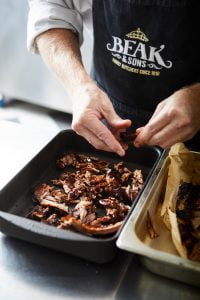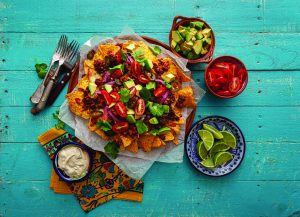Australians consume a substantial amount of meat. Depending on the source, figures suggest Aussies in recent years have been eating almost 110kg per capita each year.

In contrast, one in three Australians are limiting their meat consumption, while a further one in 10 are already following a meat-free diet (Life Health Foods and Food Frontier, ‘Hungry for Plant-Based’, 2019).
With obvious demand for ‘genuine’ meat, as well as plant-based alternatives, all segments of the market are exploring innovation and variety to keep on top of a wide palette of tastes and trends.
Maintaining meat’s appeal
Australian consumption of beef was estimated at 27kg per capita for 2019, according to the Meat & Livestock Australia’s (MLA) ‘Market Snapshots: Beef & Sheep’ (August 2019).
Overall awareness of beef is “high” among Australians (MLA Global Consumer Tracker Australia, 2018). In 2018-19, beef had the highest share of retail sales of any meat with around a 34 per cent share of fresh meat sales by value (Nielsen Homescan, supplied by MLA).
Beef’s strengths, says MLA, centre on its perception of being a “trusted quality” product (MLA Global Consumer Tracker Australia, 2018). Beef is also perceived as “suitable for everyday meals”, compared with other proteins such as lamb, seafood and pork, but is behind chicken on this measure.
MLA believes there’s an opportunity to increase beef’s appeal by reinforcing quick, easy and convenient ways in which it can be prepared for everyday healthy meals, especially when it comes to boosting consumer confidence in preparing beef (MLA Global Consumer Tracker Australia, 2018).
When consumers are shopping for beef, MLA says, the key information they look for on the pack relates to freshness, then price, followed by elements such as “naturalness” and quality grading or guarantee (MLA Global Consumer Tracker Australia, 2018).
In 2019, Australians were estimated to have consumed 8.6kg of lamb per capita (MLA, ‘Market Snapshots: Beef & Sheep’, August 2019).
Awareness of lamb is also “high” among Australians (MLA Global Consumer Tracker Australia, 2018).
In 2018-19, lamb had around a 12 per cent share of fresh meat sales by value (Nielsen Homescan, supplied by MLA).
Consumers perceive lamb as “special” relative to other proteins and are often choosing it because it “tastes delicious” (MLA Global Consumer Tracker Australia, 2018). MLA, however, believes that opportunity sits with raising frequency of purchase and demonstrating the value of lamb. The organisation recommends focusing on lamb’s versatility, and recipes that are easy to prepare.
When consumers are shopping for lamb, MLA says, the key information they look for on-pack relates to freshness (meat colour and use-by date) then price (MLA Global Consumer Tracker Australia, 2018).
Australians consumed 21.91kg of pork per capita in 2019 (OECD, Meat Consumption, 2020).
According to the Australian Pork Limited (APL) ‘Year in Review 2018-2019’, Australian pork maintained “attractiveness” to consumers during the 12 months, although APL says in its ‘Annual Report 2018-2019’ that Australians are less familiar with pork, which it says isn’t as top of mind as beef or chicken, with many households eating chicken breast, beef mince or sausages most weeks.
Among APL’s many programs is one that focuses on retaining existing customers, seeking to encourage them to consume more fresh pork by providing options to include other proteins with the meat and unlock new meal opportunities.
Another program is focused on converting desire for Australian pork into sales. This involves collaborating with supermarket and eating-out chains, individual butchers and independent supermarket owners, as well as individual restaurants and chefs. These sales, says APL, increase demand for pigs and the price the producer receives.
Poultry remains top of pecking order
The trend towards chicken continues to grow, with Australians forecast to consume 49.2kg of chicken per person in 2020-21, according to Australian Chicken Meat Federation. This is expected to rise to 51.5kg by 2023.
Supermarket retailers are also experiencing this strong demand for poultry, with sales of fresh poultry up nine per cent across fresh meat (packaged and deli), while crumbed poultry sales in the freezer category are up 18.9 per cent in the past MAT vs YA (IRI Market Edge, MAT to 28/6/20, supplied by Baiada).
The major shift in category sales has been within the fresh packaged poultry category (up 11.5 per cent) as shoppers decide against deli products (down 5.8 per cent versus a year previously).
“Shoppers are starting to shift away from the deli and look to the packaged meat case area for their weekly shop,” says Baiada Head of Marketing Yash Gandhi. “We expect this will continue to grow as shoppers prefer packaged meats over deli as an alternative.
“The pandemic and its associated limitations on eating out are influencing shoppers to renew their interest in home cooking, not only from a health perspective, but also in bonding with their families and showcasing their creations and recipes on social media.”
Succeeding with plant-based

In the 12 months to May this year, major supermarket sales of plant-based protein and vegetarian foods grew strongly, up 40 per cent (IRI MarketEdge Data, Plant Based Protein and Vegetarian categories, MAT to 24/5/20, supplied by Life Health Foods).
The category in Australia, however, is still in its infancy, according to v2food CEO Nick Hazell, following the lead set by UK and US markets.
“There has been huge variability in the range, from high-priced imported products through to low-quality options,” he says. “It’s clearly been a challenge for retailers to maintain stock levels at a consistent price.
“As the category moves into the next stage of growth with more consistent quality, there’ll be more consumers trialling and converting to repeat purchase. This will see a few lead brands emerge in the category as retailers and foodservice across Australia continue to learn how to activate plant-based meat alternatives.

“Key to this is the development of category and consumer understanding and the transition of the category moving from a niche vegan/vegetarian option to a viable and credible alternative to animal protein including location in the meat aisle.”
Read more about meat, poultry, and plant-based alternatives in the September issue of Retail World.



